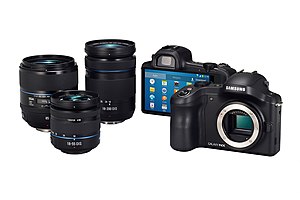LabLynx Wiki
Contents
 | |
| Overview | |
|---|---|
| Maker | Samsung Electronics |
| Type | Mirrorless interchangeable-lens camera with Digital SLR camera-shape |
| Released | June 2013 |
| Lens | |
| Lens | Interchangeable (Samsung NX-mount) |
| Sensor/medium | |
| Sensor | 20.3 megapixel APS-C CMOS image sensor |
| Maximum resolution | 20.3 megapixels |
| Film speed | ISO 100 to 3200 |
| Storage media | 16 GB, expanded via micro-SD/SDHC/SDXC up to 64 GB |
| Focusing | |
| Focus modes | Autofocus (single, continuous), manual focus |
| Focus areas | Contrast-detect 1 point AF (free selection), 15-area-focusing (normal) / 35-area-focusing (close up), face detection (max. 10 faces) |
| Exposure/metering | |
| Exposure metering | 221-segment TTL |
| Flash | |
| Flash | Built-in pop-up flash, 11 Guide Number at ISO 100 |
| Shutter | |
| Shutter | Electronically controlled vertical-run focal plane shutter |
| Shutter speed range | 1/6000 to 30 sec. and bulb (up to 4 minutes) |
| Continuous shooting | 8 fps up to 11 JPEG or 8 RAW frames, 3 fps up to 15 frames (JPEG) |
| Viewfinder | |
| Viewfinder | EVF color display, 100% field of view, 0.68x (35 mm equiv), 1.04x magnification, with 1.44M dots equivalent; and 640k dots Pentile AMOLED OCR articulated multi-angle 3-inch (76 mm) color display |
| Image processing | |
| WB bracketing | Yes |
| General | |
| LCD screen | 4.8 inch HD TFT-LCD SVGA EVF |
| Battery | 4360 mAh |
| Dimensions | 136.5 mm x 101.46 mm x 56 mm |
| Weight | 495 g |
The Samsung Galaxy NX is a hybrid mirrorless interchangeable lens camera manufactured by Samsung, announced in June 2013. The Galaxy NX is an Android (4.2.2, upgradeable to Android Jelly Bean MR1) based mobile device which is the first of its kind. It is a 20.3 megapixel camera using the Samsung NX-mount that features Wi-Fi, 3G connectivity, and a GPS receiver by which the camera can make geotagged photographs.[1]
While the device runs on Android, it is not a smartphone in the sense that it does not have a telephone function. Instead, its wireless connectivity can be used for telecommunication (including video) over the Internet.
Included software allows for in-camera organizing, editing and online sharing or storage of images and videos.[2] As with other Android devices, other software can be downloaded from Google Play.[3]
The device has a "familiar DSLR look", with a larger LCD touchscreen than is customary for that category but fewer buttons and dials.[4] The touchscreen and voice control are used primarily for controlling the camera.
The device has one processor for Android and another, DRIMe IV, for photographic processing.
The Samsung Galaxy NX was discontinued in 2017.[5][6]
References
- ^ "Samsung Galaxy NX". Samsung.com. Retrieved November 23, 2013.
- ^ Grunin, Lori. "Samsung Galaxy NX review". CNET. Retrieved November 23, 2013.
- ^ Amadeo, Ron (29 August 2013). "Samsung Galaxy NX Android camera gets official prices and specs". arstechnica. Retrieved November 23, 2013.
- ^ Les Shu (26 November 2013). "Samsung Galaxy NX review". Retrieved February 10, 2014.
- ^ Cameras, Phil Hall 2017-04-10T10:18:45 99Z (10 April 2017). "Looks like Samsung has admitted defeat and killed its camera system". TechRadar. Retrieved 2019-08-09.
{{cite web}}: CS1 maint: numeric names: authors list (link) - ^ Mathies, Mathies (4 May 2017). "After conquering cameras with the NX1, now Samsung may quit them forever". www.digitaltrends.com. Retrieved 2019-08-09.

















